

Egypt in the New Kingdom (ca. 1550–1070 B.C.) Internet History Sourcebooks. Internet Ancient History Sourcebook: Egypt See Main Page for a guide to all contents of all sections.
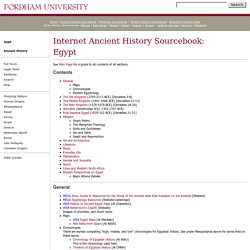
General MEGA Abzu: Guide to Resources for the Study of the Ancient Near East Available on the Internet [Website] MEGA Egyptology Resources [Website-Cambridge] WEB History of Ancient Egypt Page [At Charleston] WEB Neferchichi's ClipArt [Website] Images of divinities, and much more. Maps Chronologies There are myriad competing "high, middle, and low" chronologies for Egyptian history. See under Mesopotamia above for some links on these issues. Back to Index The Old Kingdom (2705-2213 BCE) [Dynasties 3-8] The Palette of Narmar 3200BC [At Then Again] The Instruction of Ptah-Hotep, 6th Dynasty [This Site] The Instruction of Ptah Hotep 6th Dynasty (2300-2150 BCE)[in Egyptian][on AOL] Contains Middle Kingdom copies of an Old Kingdom text.
The New Kingdom (1570-1070 BCE) [Dynasties 18-20] Akhnaten [Amenhotep IV](r. 1363-1347 BCE) Cairo. Egypt. Egypt Web Sites Mark Millmore’s Ancient EgyptMark Millmore’s fun and educational site is comprehensive, updated daily, and features several great sections.
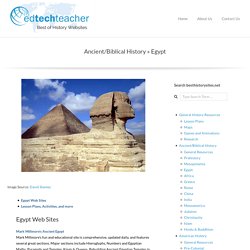
Major sections include Hieroglyphs, Numbers and Egyptian Maths, Pyramids and Temples, Kings & Queens, Rebuilding Ancient Egyptian Temples in 3D, Ancient Egyptian Videos and Documentaries, The Discovering Egypt Newsletter, and Ancient Egyptian Quizzes. The Ancient Egypt Site. Ancient Egyptian collection. Who were the Sea Peoples? For nearly a century in the second millennium B.C., a mysterious band of maritime warriors known as the “Sea Peoples” wreaked havoc on the Mediterranean.
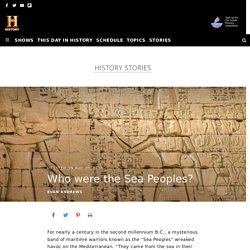
“They came from the sea in their warships,” reads one ancient inscription, “and none could stand against them.” There are accounts of the Sea Peoples attacking Egypt, Turkey, Syria and Palestine. They may have even toppled the mighty Hittite Empire, yet despite the indelible mark they left on history, scholars know almost nothing about their culture or nationality. What little information historians have on the Sea Peoples comes from the civilizations that fought wars against them, most notably the ancient Egyptians.
Sea Peoples. The Sea Peoples were a confederacy of naval raiders who harried the coastal towns and cities of the Mediterranean region between c. 1276-1178 BCE, concentrating their efforts especially on Egypt.
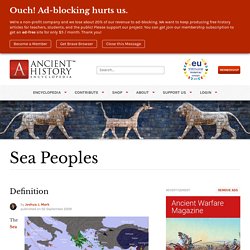
The nationality of the Sea Peoples remains a mystery as the existing records of their activities are mainly Egyptian sources who only describe them in terms of battle such as the record from the Stele at Tanis which reads, in part, “They came from the sea in their war ships and none could stand against them. " This description is typical of Egyptian references to these mysterious invaders. Egyptians and Libyans in the New Kingdom. For Classical authors such as Herodotus (ca. 450 B.C.), all the various independent people inhabiting the huge land mass extending west from Egypt to the Atlantic Ocean were called “Libyans.”

For convenience, we can also employ this general term for the Bronze Age inhabitants of the area. The Egyptians of the New Kingdom (1500-1050 B.C.), however, referred to their western neighbors as the “Tjehenu” and “Tjehemu.” Their texts also mention specific subgroups called the “Meshwesh” and the “Ribu” or “Libu” —from which our modern word Libyan is derived. Other rare names seem to refer to smaller tribal groups. Kadesh. The Battle of Kadesh & the First Peace Treaty. The Hittites and Ancient Anatolia (article) The Hittites.
The Hittites occupied the ancient region of Anatolia (also known as Asia Minor, modern-day Turkey) prior to 1700 BCE, developed a culture apparently from the indigenous Hatti (and possibly the Hurrian) people, and expanded their territories into an empire which rivaled, and threatened, the established nation of Egypt. They are repeatedly mentioned throughout the Hebrew Tanakh (also known as the Christian Old Testament) as the adversaries of the Israelites and their god. According to Genesis 10, they were the descendants of Heth, son of Canaan, who was the son of Ham, born of Noah (Genesis 10: 1-6). Egyptian Agriculture. The Scribe and Hieroglyphs. Scribes, slong with the foremen, were captains over workers in a village and were the liaison between the community and the higher authorities.

Their duties included recording the activities of the village, overseeing the use of material from the royal storehouses, receiving and distributing wages, recommending candidates for vacancies in the workforce, as well as being chief magistrates in the local court and chief witnesses for any oaths. Hieroglyphs Hieroglyphs, which combine both art and language, were holy signs which were mainly intended to decorate the walls of temples, tombs or pyramids.
It was written in both columns and rows, depending on the design of the text. Haremhab as a Scribe of the King. Scribes in ancient Egypt. It is no exaggeration to say that we owe most of our knowledge of ancient Egypt to the work of her scribes.
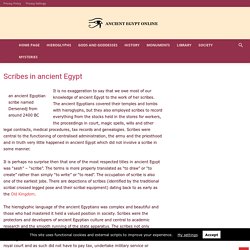
The ancient Egyptians covered their temples and tombs with hieroglyphs, but they also employed scribes to record everything from the stocks held in the stores for workers, the proceedings in court, magic spells, wills and other legal contracts, medical procedures, tax records and genealogies. Scribes were central to the functioning of centralised administration, the army and the priesthood and in truth very little happened in ancient Egypt which did not involve a scribe in some manner. Egyptian Social Structure. Egyptian society was structured like a pyramid.
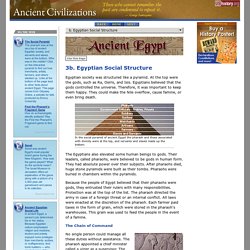
At the top were the gods, such as Ra, Osiris, and Isis. History - Ancient History in depth: From Warrior Women to Female Pharaohs: Careers for Women in Ancient Egypt. Egypt's Golden Empire . New Kingdom. The position of women in the New Kingdom was based on a unique combination of ancient tradition and modern sophistication.

The opportunities available to most women were limited by centuries of tradition and deeply held religious beliefs. But women also had legal and financial rights that were remarkably modern and sophisticated. This was in marked contrast to the customs in other cultures during the same period. Know your place Egyptian society was highly structured: a woman's social position was largely defined by the status of her father and husband. Only men were allowed to work in the government, so only they could hold real power. Women in power Very occasionally, a woman ruled in her own right. Outside the royal family, women were allowed to take paid work. A woman's place Few women actually worked outside the home as it was frowned on. WOMEN IN ANCIENT EGYPT. By James C.
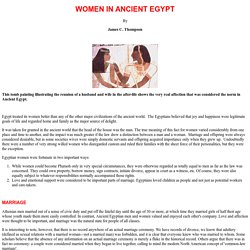
Thompson This tomb painting illustrating the reunion of a husband and wife in the after-life shows the very real affection that was considered the norm in Ancient . treated its women better than any of the other major civilizations of the ancient world. Trade in Ancient Egypt. Trade has always been a vital aspect of any civilization whether at the local or international level. However many goods one has, whether as an individual, a community, or a country, there will always be something one lacks and will need to purchase through trade with another. Ancient Egypt was a country rich in many natural resources but still was not self-sufficient and so had to rely on trade for necessary goods and luxuries. Trade began in the Predynastic Period in Egypt (c. 6000 - c. 3150 BCE) and continued through Roman Egypt (30 BCE-646 CE). For most of its history, ancient Egypt's economy operated on a barter system without cash. It was not until the Persian Invasion of 525 BCE that a cash economy was instituted in the country.
Goods and services were valued on a unit known as a deben. From Local to International Trade Trade began between Upper and Lower Egypt, and between the different districts of those regions, prior to unification c. 3150 BCE. Traded Goods. Karnak. Towns and Houses of the New Kingdom - The Complete Cities of Ancient Egypt. It is perhaps unsurprising that the evidence for life and work in the New Kingdom comes from two settlements that are unique – the workers’ village of Deir el-Medina (which provides the best evidence, both archaeological and textual, of any period from anywhere in Egypt) and the new-build foundation of Akhenaten at Amarna – because the special reasons for their creation are the same reasons that their evidence has been preserved: their less fertile locations away from the majority of settlement.
The city of Amarna will be described in the Gazetteer, but in this section that follows its Workmen’s Village will briefly be compared with the vast array of evidence from Deir el-Medina. The Village – Deir el-Medina The village of Deir el-Medina is far and away the most important source of evidence for towns and villages in ancient Egypt. Excavation History A Royal Town for Royal Tombs. The First Labor Strike in History. The Tomb of Pharaoh Seti I: A Missing Mummy, An Unexpected Tunnel and a Mummified Bull. The mummified face of Pharaoh Sety I (Seti I) still shows that he was not only extremely powerful but also very handsome during his lifetime. Sety’s tomb was brought back to the world on October 16, 1817 by the rebellious researcher Giovanni Battista Belzoni.
It was an amazing find, but when the door was opened, destruction and confusion soon followed. It all began with the mystery of the missing mummy… Daily Life in Ancient Egypt. An Artisan’s Tomb in New Kingdom Egypt. Deir el-Medina. Ancient Egypt and Archaeology Web Site - Ancient Egypt - Deir el Medina. Louvre depth studies deir medina. Ancient Egypt. Egyptian Government. Egyptian civilization - Religion - Kingship. The Ancient Egypt Site. Egyptian Empire. Ramesses II. Ramesses II (1279-1213 BCE, alternative spellings: Ramses, Rameses) was known to the Egyptians as Userma’atre’setepenre, which means 'Keeper of Harmony and Balance, Strong in Right, Elect of Ra’.
Thutmose III. Ancient Egypt: How volcanoes brought down last kingdom. SUN-CHOKING debris cast off by volcanoes more than 2000 years ago starved headwaters feeding the Nile river and hastened the downfall of ancient Egypt’s last kingdom, researchers claim. Faced With Drought, the Pharaohs Tried (and Failed) to Adapt. Egypt's Golden Empire . New Kingdom. New Kingdom of Egypt. Queen Hatshepsut: Daughter of Amun, Pharaoh of Egypt. The Temple of Hatshepsut. Hatshepsut. Hatshepsut (1479-1458 BCE) was the first female ruler of ancient Egypt to reign as a male with the full authority of pharaoh.
Her name means "Foremost of Noble Women" or "She is First Among Noble Women". She began her reign as regent to her stepson Thuthmose III (1458-1425 BCE) who would succeed her and, initially, ruled as a woman as depicted in statuary. Women of the Eighteenth Dynasty in Ancient Egypt. New Kingdom of Egypt. Ancient Egypt - The Middle Kingdom (1938–c. 1630 bce) and the Second Intermediate period (c. 1630–1540 bce) Civilization, Geography, & History. Hatshepsut: Powerful Female Pharaoh. The Queen Who Would Be King. (2) The pharaoh that wouldn't be forgotten - Kate Green.
Women of the Eighteenth Dynasty in Ancient Egypt. Ancient Egypt - The Middle Kingdom (1938–c. 1630 bce) and the Second Intermediate period (c. 1630–1540 bce)